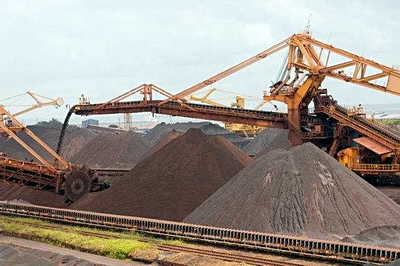 Home > News
Home > News



The heat came out of China's iron ore imports in April, with vessel-tracking and port data suggesting a decline of several million tonnes from the near-record levels recorded in March.
A total of 83.27 million tonnes of the steel-making ingredient was discharged at Chinese ports in April, down 3.7 per cent from March's 86.46 million, according to data compiled by Thomson Reuters Supply Chain and Commodity Forecasts.
It's worth noting that the vessel-tracking and port data typically comes in below the official Chinese customs data, which reported 95.56 million tonnes of iron ore imports in March, the second-highest on record.
Nonetheless, the ship data does point to lower imports in April, most likely in the order of 3 million tonnes. Apart from a weak month in February, most likely related to the Lunar New Year holidays, the vessel-tracking figures show April to be the weakest month for iron ore imports since September last year.
It also appears that much of the decline in iron ore imports was borne by Australia, China's largest supplier, with the data showing imports of 53.9 million tonnes in April, down from 58.9 million in March.
In contrast, number two supplier Brazil saw Chinese imports of 18.48 million tonnes in April, up from March's 16.54 million. The lower imports from Australia in April are most likely the result of earlier weather-related disruptions in the main producing area of Western Australia state that affected both mines and rail networks.
This means imports from Australia are likely to recover again in May, which may be a bearish signal for prices if miners such as Rio Tinto, BHP Billiton and Fortescue Metals Group decide to chase volumes over prices.
Steel output robust, but for how much longer?
This can already partly be seen by the 11 per cent jump in iron ore shipments from Port Hedland, the terminal used by BHP and Fortescue, to 34.86 million tonnes in April from 31.5 million in March. This tallies with the Chinese import numbers from Thomson Reuters, given the sailing time of around two weeks between northwest Australia and China.
Ultimately iron ore prices are driven by steel prices and margins, and here the outlook is less certain, with the main Shanghai rebar contract trending lower in recent weeks. It hit a peak of 3440 yuan ($US499) a tonne on March 15, but slipped 9.2 per cent since then to Wednesday's close of 3123 yuan, as doubts emerged among market participants over the resilience of China's infrastructure and construction spending.
While Chinese steel output has remained robust so far this year, the market seems to be swinging toward the view that margins will be under pressure in the second half of the year as domestic demand growth slows and exports struggle.
Already Chinese steel mills are seeing lower exports, with shipments of products sent overseas slumping 25 per cent to 20.72 million tonnes in the first quarter of this year compared to the same period last year.
While exports are by no means the key factor for the 800 million tonnes-a-year Chinese steel sector, a significant downturn is another bearish factor for the industry.
Spot Asian iron ore prices have performed worse than Chinese steel rebar futures in recent weeks, dropping 31 per cent from a peak of $US94.86 a tonne on February 21 to $US65.20 on Thursday.
Supply tightness fades
The sharp decline is partly due to the strong rally over the past 13 months, which saw prices almost triple, sending iron ore to levels that appeared well overbought, given the market remains well supplied and will have to absorb more than 100 million tonnes of new low-cost production from Australia and Brazil this year and next.
While China buys about two-thirds of seaborne iron ore, this still leaves one-third that can influence the market, and here the recent news has been fairly positive for the major exporters.
Japan's imports of iron ore in April reached the highest since vessel-tracking data started in January 2015, with 11.62 million tonnes discharged during the month, up from 10.45 million the prior month.
Asia's third-largest importer, South Korea, saw 7.17 million tonnes offloaded in April, the most since October 2015, according to the data.
While import volumes in Japan and South Korea are dwarfed by China's, it does show signs of health in the steel sectors in those countries, which is overall a mild positive for seaborne iron ore demand.
The picture that is emerging is that April's dip in China's iron ore imports is likely related to earlier weather issues in Australia, and, given that shipments have already recovered, there is unlikely to be any supply tightness.
This leaves the price exposed to Chinese demand, and here the outlook is less certain and will depend on how much spending stimulus the authorities in Beijing deem appropriate.
XINSTEEL NEWS